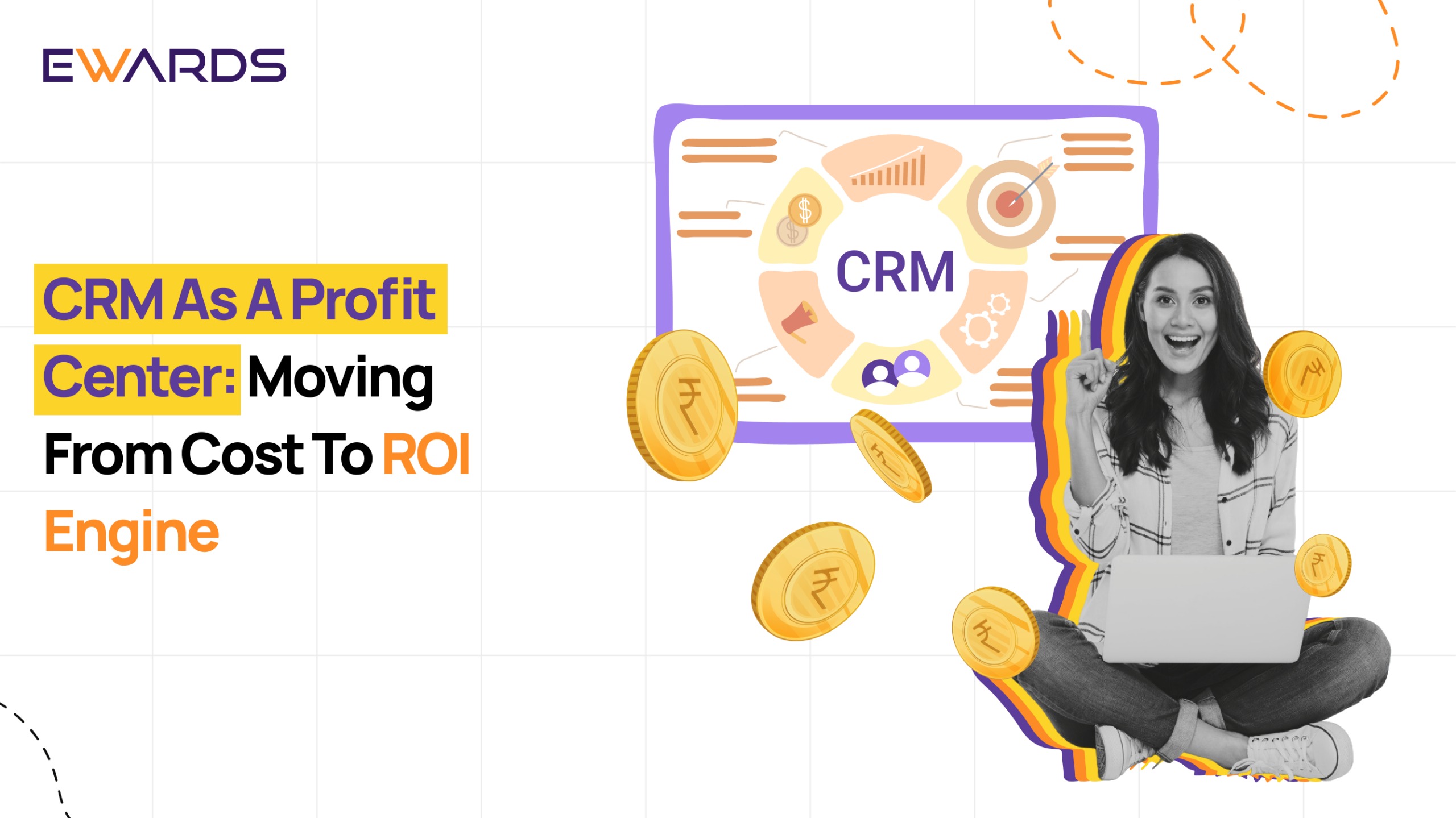
Businesses believe that Customer Relationship Management (CRM) is a cost center. They take it as a necessary operational tool for managing customer data, inquiries, and transactions. But what if we told you that CRM can actually become one of the most powerful ROI engines in your business if you knew how to use it right?
We have by now learned that customer acquisition is 5 to 25 times more expensive than customer retention. Yet, most businesses continue to treat CRM as an expense because they primarily use it for support and data storage, rather than as a profit-generating asset.
The truth is, CRM was not just built for keeping track of customer information; It was actually an innovative solution for driving revenue by using strategies like targeted engagement, personalized experiences, and loyalty-building strategies. Businesses can enjoy significant growth and enhance their profitability 100-fold just by transforming CRM from a cost center into a strategic ROI driver.This blog will show you how shifting your mindset around CRM can lead to measurable returns by focusing on customer retention, lifetime value (CLV), and data-driven marketing strategies.
Why is CRM Seen as a Cost Center?
In the long run, CRM has primarily been viewed as a support function that acts as a tool for managing customer data. While this approach is still prevalent in many businesses, the mindset around CRM is shifting. As businesses increasingly recognize the importance of customer loyalty and retention, CRM is becoming a central element of broader business strategy.
Initially, business owners and decision-makers often treated CRM as an expense rather than an asset. This cost-focused view limited the scope of CRM’s potential, thereby resulting in underinvestment and poor integration across departments. But with the rise of data analytics, personalized marketing, and customer-centric strategies, CRM now plays a much bigger role in driving business growth and improving customer lifetime value (CLV).
Marketing Accountability Framework- A Theory That Shows CRM As ROI
According to the Marketing Accountability Framework, marketing activities are related to measurable outcomes. It makes sure that every penny spent on marketing and CRM yields a positive return. This framework highlights accountability, performance metrics, and data-driven decisions to make sure that marketing (and CRM) efforts contribute directly to profitability.
This highlights that the role of CRM begins with managing customer relationships and ends with driving business results. Different CRM activities like customer segmentation, personalized communications, loyalty programs, and customer feedback loops can all be tied to specific revenue outcomes like increased retention rates, higher average order values (AOV), and more repeat customers.
How CRM Drives Customer Retention & Enhances Lifetime Value
Customer retention and customer lifetime value (CLV) are two of the most critical metrics for sustainable growth. While acquiring new customers is important, retaining them and maximizing the value derived from each customer relationship is far more cost-effective and profitable in the long run. Customer Relationship Management (CRM) plays a pivotal role in driving both of these outcomes by fostering stronger relationships and creating personalized experiences that keep customers coming back for more.
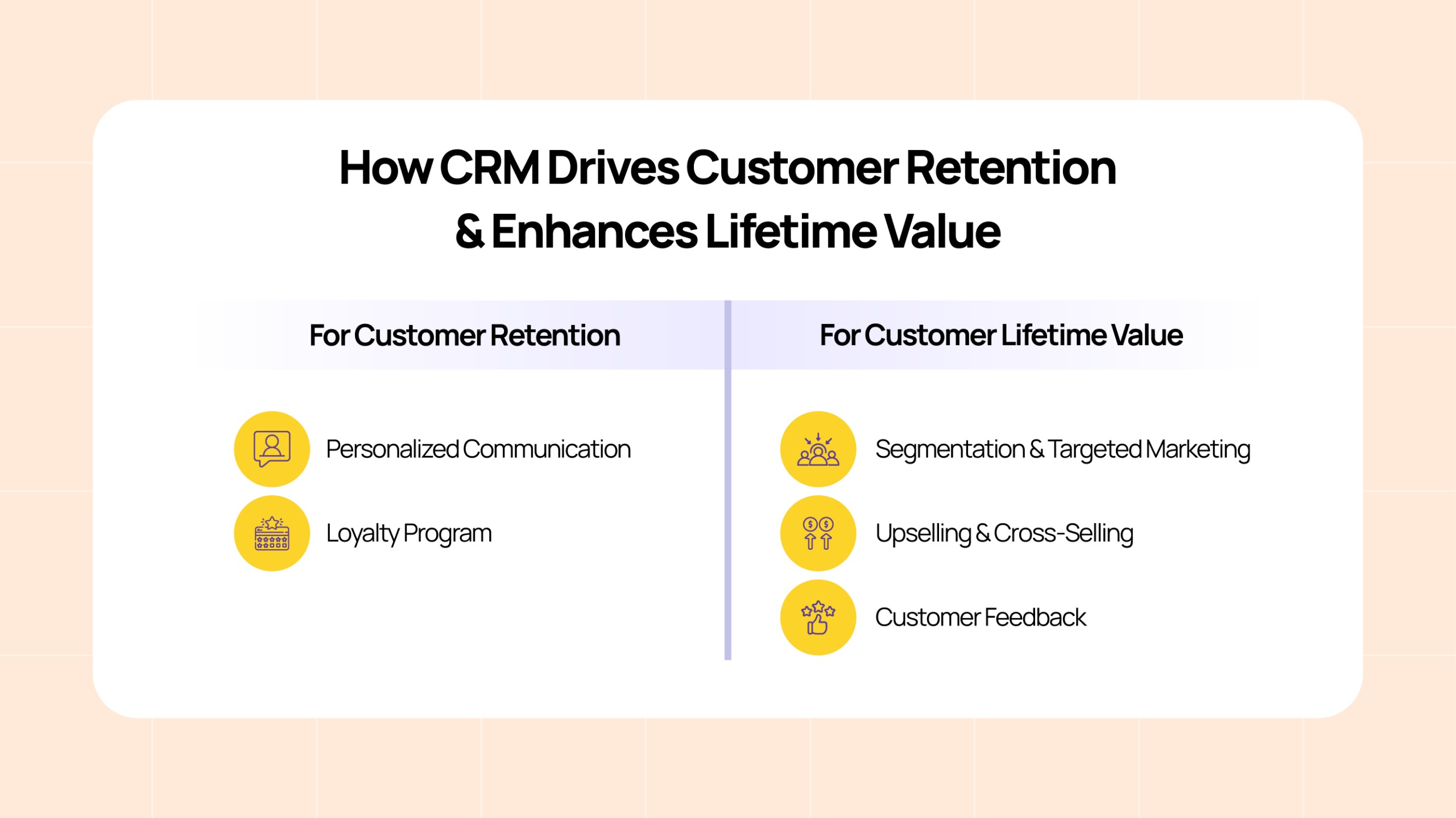
For Customer Retention
While acquiring new customers is essential, customer retention is far more cost-effective. According to an Invesp article, repeat customers spend up to 67% more than first-time buyers, making retention the most lucrative strategy for driving growth.
- Personalized Communication – CRM allows businesses to send tailored emails, SMS, and offers based on customer behavior. Personalized communication leads to higher engagement and increases the likelihood of repeat purchases. This can be backed by the data provided by Epsilon, according to which 80% customers expect personalized communication.
- Loyalty Program – Businesses can automate loyalty rewards and reminders using a CRM, which boosts customer engagement and enhances their CLV. CRM-based retention strategy via Loyalty Program has been observed in Sephora’s Beauty Insider Program, which highlighted that it drives 80% of their sales through loyalty members.
For Customer Lifetime Value
- Segmentation & Targeted Marketing – CRM allows businesses to segment customers by behavior, ensuring that high-value customers receive personalized offers and relevant communications. McKinsey found that segmented marketing can improve customer retention by up to 30%.
- Upselling & Cross-Selling – With the insights attained from CRM, businesses can recommend complementary products and increase the average order value (AOV) and CLV. Amazon’s personalized recommendations are a prime example of this, leading to increased sales per customer.
- Customer Feedback – CRM tools help collect feedback through NPS surveys and reviews, allowing businesses to improve their offerings and enhance customer satisfaction. NPS is proven to increase retention by up to 6.9% (CustomerGauge).
CRM Strategies To Boost ROI
To move CRM from a cost center to an ROI engine, businesses need to implement targeted, data-driven strategies. Here are some CRM strategies that can drive measurable returns:
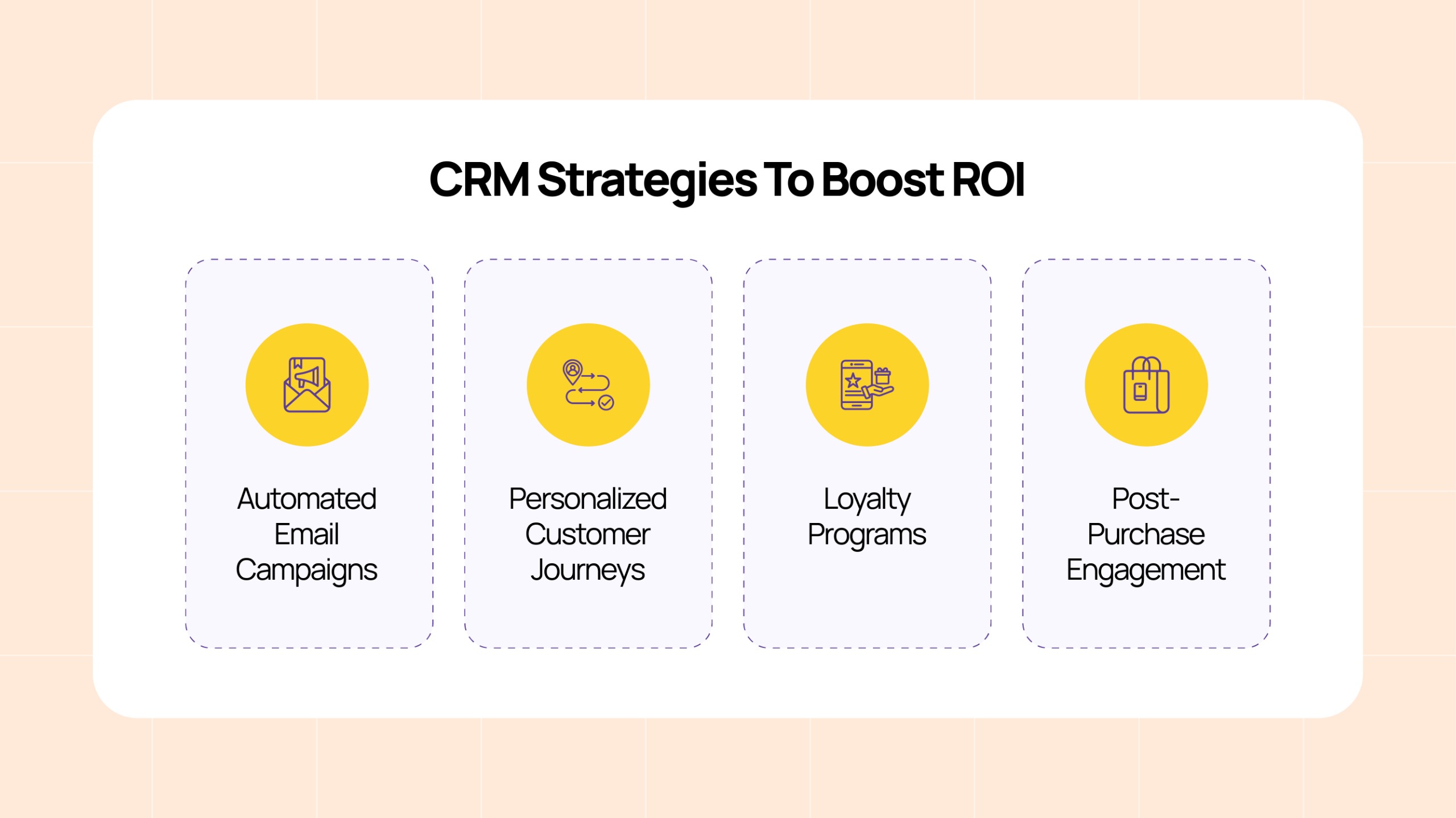
- Automated Email Campaigns
Email remains one of the most effective channels for CRM engagement. According to Campaign Monitor, emails with personalized subject lines generate 26% higher open rates. Businesses can use CRM to automate follow-up emails, recommend relevant products, and offer discounts to keep customers engaged after the initial purchase.
- Personalized Customer Journeys
With RM data, businesses can create personalized experiences that align with customer preferences. Personalization boosts engagement, with 80% of consumers stating they’re more likely to make a purchase when brands offer personalized experiences (Epsilon). This can include recommendation engines, loyalty rewards, and tailored offers based on past behavior.
- Loyalty Programs
Rewarding customers for their continued business not only increases retention but also drives more purchases. A well-structured loyalty program can increase revenue by 15-20% within the first year of implementation (Zinrelo). Businesses can track loyalty points, send reminders for reward redemption, and deliver exclusive perks that encourage repeat buying behavior through their CRM.
- Post-Purchase Engagement
CRM tools allow brands to engage customers after a purchase, enhancing their experience and increasing the likelihood of a repeat purchase. Targeted surveys, NPS (Net Promoter Score), and feedback loops give businesses insights into customer satisfaction and areas for improvement, turning satisfied customers into long-term advocates.
Measuring CRM Performance
To truly understand the value CRM brings, businesses must measure its impact on bottom-line growth. Businesses can track the effectiveness of CRM initiatives and adjust their strategies by using the Key Performance Indicators (KPIs). Some of them are:
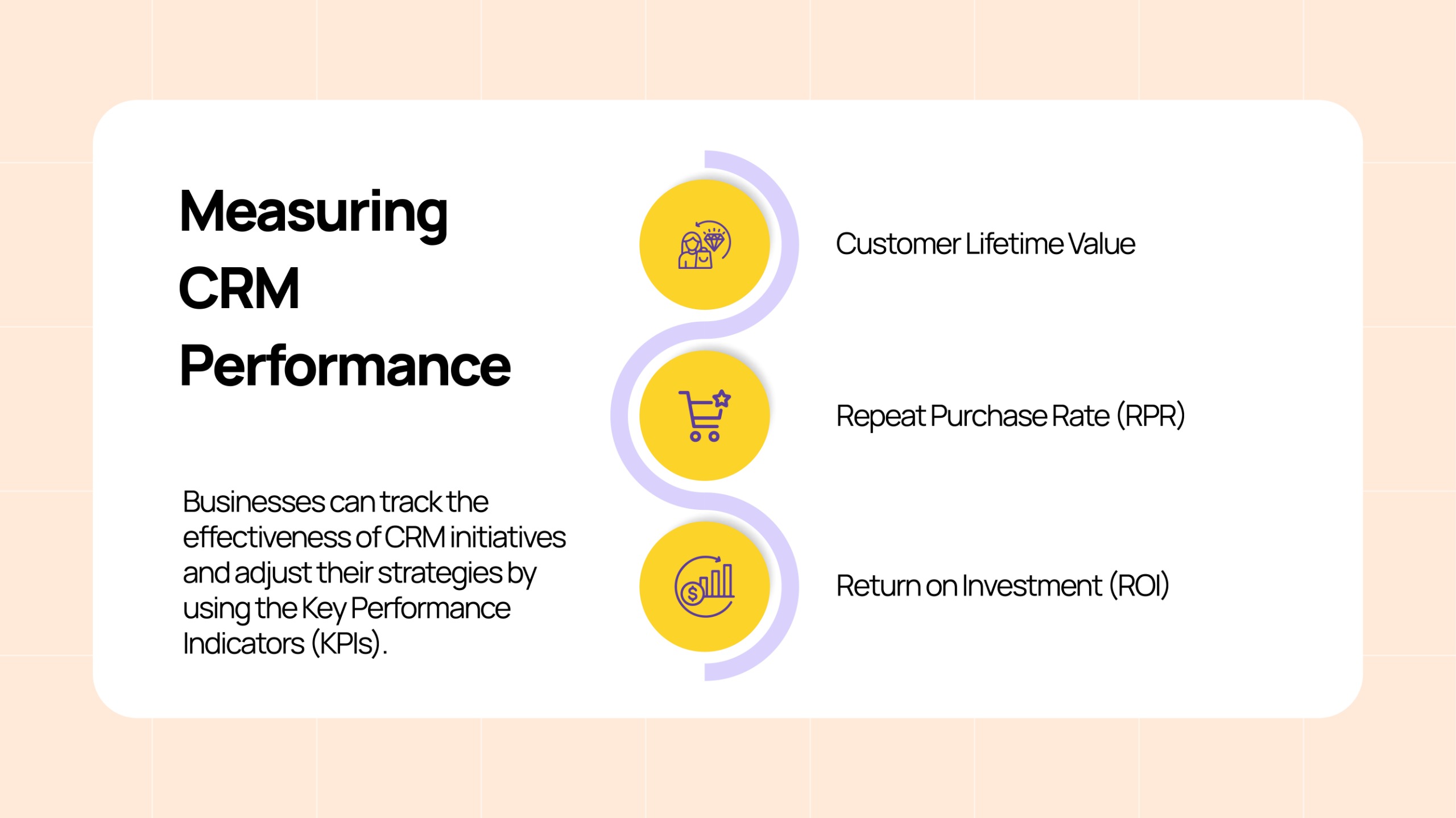
- Customer Lifetime Value – It measures the total revenue a customer is expected to generate during their relationship with the brand. A higher CLV indicates effective post-purchase engagement and customer loyalty.
- Repeat Purchase Rate (RPR) – It helps businesses track how often customers return to make another purchase. A higher RPR means CRM efforts are successfully driving retention and repeat business.
- Return on Investment (ROI) – Businesses can calculate ROI by comparing the revenue generated from CRM activities (e.g., loyalty programs, upselling) to the cost of implementing CRM systems and strategies.
Brands That Are Using CRM To Drive Profit
Domino’s
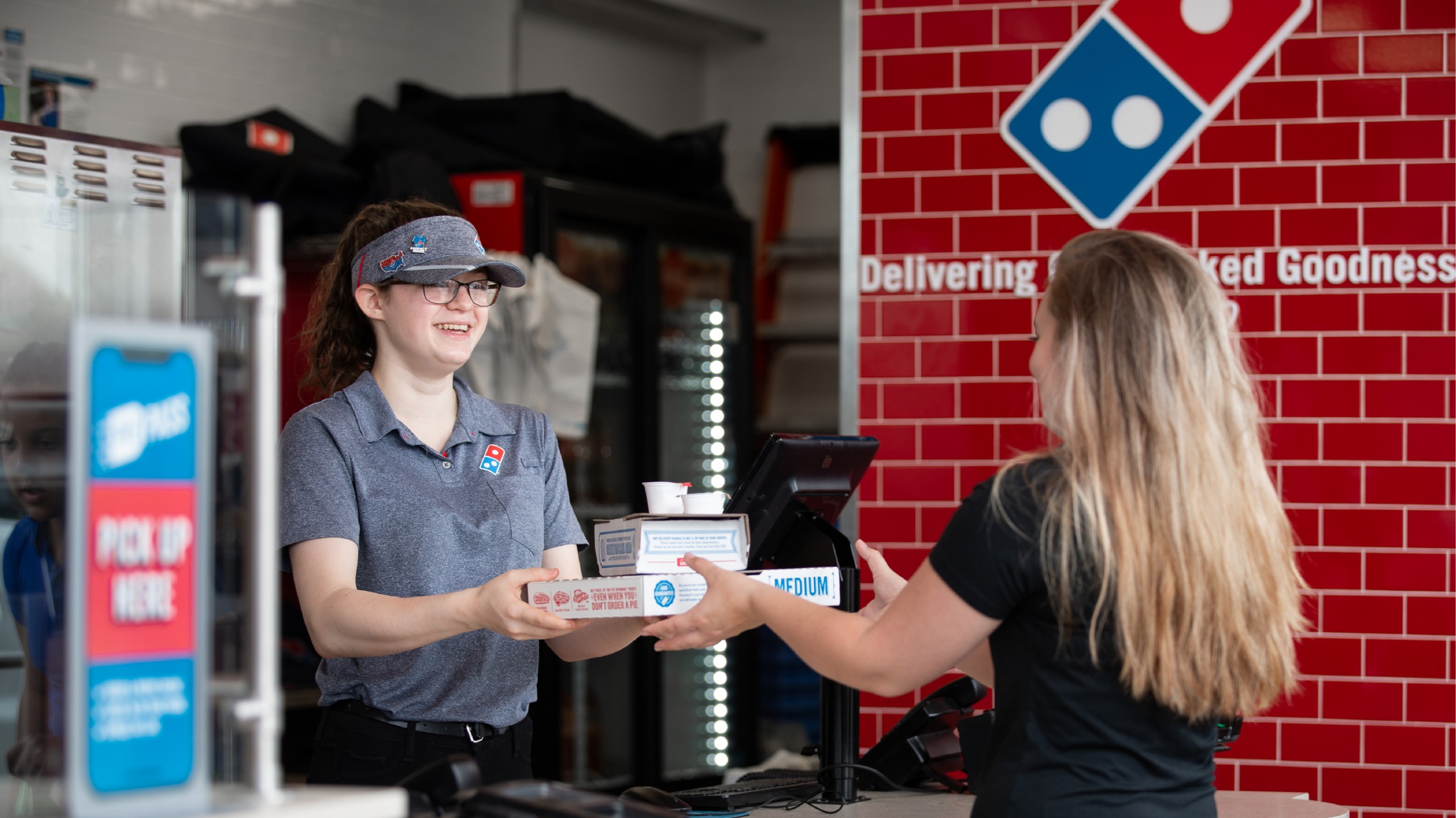
Domino’s personalizes the customer experience with their CRM, where predictive analytics help them in forecasting when customers would want to reorder based on their past behavior. This strategy has helped them drive repeat business and significantly boosted sales, observing a 6% increase in revenue year-over-year in their key markets.
Nike

Nike’s CRM strategy, particularly through its Nike Membership Program, encourages repeat purchases by offering personalized workout plans, product recommendations, and early access to new releases. The Nike Training Club app collects data to provide tailored experiences, resulting in strong customer retention rates and increased sales.
Conclusion
Businesses that are looking to stay competitive need to incorporate CRM. By focusing on customer retention, personalization, and data-driven decisions, CRM can transform from a simple tool to a powerful ROI engine. Whether you’re in retail, F&B, or any other industry, shifting CRM’s role from a cost center to a strategic asset will drive long-term revenue, foster loyalty, and maximize profitability.
Is your CRM system working for you, or is it just another expense?